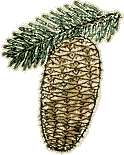
THE PANGOLIN-AND-PINECONE EFFECT
In investigating the world, similarities of form, structure and function are among the places where we begin to recognize the interrelationships of objects. Sixteenth-century collectors were fascinated by such correspondences and convergences, and were well versed in the poetics of visual comparison and what we would term interdisciplinary connections. In order to introduce the exhibition visitor to the associative process intrinsic to the sixteenth-century structure of knowledge, we set up three groups of objects at the entrance of our curiosity cabinet to serve as examples of how to "read" such a space.
 |
The grouping most central to an understanding of the sixteenth-century world view was a case containing a pinecone and a plastic pineapple set up next to a pangolin skin mounted on the wall. The visual structure of the surface of the pangolin, the pinecone and the pineapple reveal the repetition of simple geometric forms that create surfaces that are both decorative and protective. By grouping these three objects--a grouping unlikely to occur either in nature or in the contemporary classroom--we encouraged the viewer to consider the visual correspondences between objects, which in many cases may reveal other important connections. For example, etymologically, our word "pineapple" reflects the recognition of the similarity of form between the fruit and the pinecone, both of which contain edible interiors beneath their armored exteriors.
 We also paired a display of plastic fruit (borrowed from the French department,
which uses the fruit as a teaching tool) with a painting of a fruit still life.
The juxtaposition suggests the different levels of reality, from the actual object
to the two-dimensional rendition of it (perhaps recalling Plato's critique of the
visual arts to the viewer's mind). But the hierarchy this set-up seems to imply is
inverted when we consider the fact that the plastic fruit is itself an inexpensive
representation while the painting is a valuable object in its own right.
We also paired a display of plastic fruit (borrowed from the French department,
which uses the fruit as a teaching tool) with a painting of a fruit still life.
The juxtaposition suggests the different levels of reality, from the actual object
to the two-dimensional rendition of it (perhaps recalling Plato's critique of the
visual arts to the viewer's mind). But the hierarchy this set-up seems to imply is
inverted when we consider the fact that the plastic fruit is itself an inexpensive
representation while the painting is a valuable object in its own right.
The third pair was of a mounted caribou head and a wave form, carved from a plexiglass block for a machine to test wave formations for the Navy. The curves of the wave form echoed the antlers of the caribou, but the two objects also set up a contrast between nature and a high-tech imitation of it.
As whimsical as these juxtapositions seem to the modern eye, they do point out an
important function of the Curiosity Cabinet. Through the diversity and the sheer
abundance of objects assembled within it, the Cabinet of Curiosity permitted
scholars to perform comparative analysis of materials, to begin to sort out the
norms and the extremes of different categories. Much of modern science and
virtually all of the modern humanities use comparative analysis of examples or
specimens as the basic technique for studying their subject matter. Just as in the
sixteenth century, repetition of forms and even objects across disciplinary
boundaries is common, and helps us to recognize common interests or distinguish
divergent goals. For the sixteenth century, such echoes confirmed the sense of an
underlying logic to the world at large. For us, it allows us to recognize that
objects within the world yield different sorts of information, or have different
values, according to the questions we ask about them. In all cases, comparison
requires access to a large enough body of material to make such analysis
meaningful. This is one of the most important functions of university collections
today, and was one of the primary motivations for assembling collections in the
past.
 |
{Essays} {Gallery} {Microcosms} |
 |